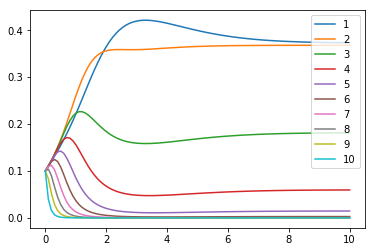Example¶
In [1]:
# NBVAL_IGNORE_OUTPUT
%load_ext watermark
import qutip
import numpy as np
from numpy import pi
import matplotlib
import matplotlib.pylab as plt
import newtonprop
%watermark -v --iversions
qutip 4.3.1
numpy 1.15.4
matplotlib 3.0.2
matplotlib.pylab 1.15.4
newtonprop 0.1.0
CPython 3.6.7
IPython 7.2.0
QuTiP Model¶
We consider the example of a driven harmonic oscillator with spontaneous decay, truncated to 10-levels. The dynamics start from the totally mixed state.
In [2]:
def liouvillian(N=10):
two_pi = 2.0 * pi
w_c = two_pi * 0.01
gamma = two_pi * 0.1
E0 = 0.5
# Drift Hamiltonian
H0 = np.array(np.zeros(shape=(N, N), dtype=np.complex128))
for i in range(N):
H0[i, i] = i * w_c
# Control Hamiltonian
H1 = np.array(np.zeros(shape=(N, N), dtype=np.complex128))
for i in range(1, N):
H1[i-1, i] = np.sqrt(float(i))
H1[i, i-1] = H1[i-1, i]
# Total Hamiltonian
H = H0 + E0 * H1
# Dissipator
a = np.array(np.zeros(shape=(N, N), dtype=np.complex128))
for i in range(1, N):
a[i-1, i] = np.sqrt(i)
a_dag = a.conj().T
return qutip.Qobj(H), [qutip.Qobj(a), ]
In [3]:
def rho_mixed(N=10):
rho = np.matrix(np.zeros(shape=(N, N), dtype=np.complex128))
rho[:, :] = 1.0 / float(N)
return qutip.Qobj(rho)
In [4]:
H, c_ops = liouvillian()
In [5]:
rho0 = rho_mixed()
In [6]:
L = qutip.liouvillian(H, c_ops)
In [7]:
tlist = np.linspace(0, 10, 100)
Reference Dynamics¶
We can use QuTiP’s mesolve routine to analyze the system dynamics:
In [8]:
result_mesolve = qutip.mesolve(L, rho0, tlist)
In [9]:
def plot_pop_dynamcis(result):
data = np.array([state.diag() for state in result.states])
fig, ax = plt.subplots()
n = data.shape[1]
for level in range(n):
ax.plot(result.times, np.real(data[:, level]), label="%d" % (level+1))
ax.legend()
plt.show(fig)
In [10]:
plot_pop_dynamcis(result_mesolve)

For comparison with the Newton propagator which is supposed to be exect to a pre-specified limit (\(10^{-12}\), by default), it is better if we can compare to the propagation that results from exactly exponentiating the Liouvillian.
In [11]:
class Result():
"""Dummy class for propagation result"""
pass
In [12]:
def propagate_expm(L, rho0, tlist):
result = Result()
result.times = tlist
dt = tlist[1] - tlist[0]
states = [rho0, ]
rho = rho0
E = (L * dt).expm()
for _ in range(len(tlist)-1):
rho = E(rho)
states.append(rho)
result.states = states
return result
In [13]:
result_expm = propagate_expm(L, rho0, tlist)
In [14]:
def error(result1, result2):
err = np.linalg.norm(
result1.states[-1].full()
- result2.states[-1].full())
print("%.1e" % err)
This is our “exact baseline”. The mesolve routine is only exact to
about \(10^{-7}\).
In [15]:
error(result_mesolve, result_expm)
1.2e-07
Newton propagation of QuTiP objects¶
First, we use the Newton propagator to simulate the dynamics using QuTiP objects.
In [16]:
def zero_qutip(v):
return qutip.Qobj(np.zeros(shape=v.shape))
def norm_qutip(v):
return v.norm("fro")
def inner_qutip(a, b):
return complex((a.dag() * b).tr())
def propagate(L, rho0, tlist, zero, norm, inner, tol=1e-12):
result = Result()
result.times = tlist
dt = tlist[1] - tlist[0]
states = [rho0]
rho = rho0
for _ in range(len(tlist) - 1):
rho = newtonprop.newton(
L, rho, dt, func='exp', zero=zero, norm=norm, inner=inner, tol=tol
)
states.append(rho)
result.states = states
return result
Using the Frobenious norm here is absolutely critical: QuTiP’s default norm is not compatible with the inner product, and will lead to a subtle error.
In [17]:
result_qutip = propagate(
L, rho0, tlist, zero_qutip, norm_qutip, inner_qutip, tol=1e-12
)
In [18]:
error(result_qutip, result_expm)
8.7e-11
In [19]:
result_qutip = propagate(
L, rho0, tlist, zero_qutip, norm_qutip, inner_qutip, tol=1e-8
)
In [20]:
error(result_qutip, result_expm)
1.3e-09
Newton propagation of QuTiP objects with Cython¶
In [21]:
from qutip.cy.spmatfuncs import cy_ode_rhs
from qutip.superoperator import mat2vec
In [22]:
L_data = L.data.data
L_indices = L.data.indices
L_indptr = L.data.indptr
rho0_data = mat2vec(rho0.full()).ravel('F')
def zero_vectorized(v):
return np.zeros(shape=v.shape, dtype=v.dtype)
def norm_vectorized(v):
return np.linalg.norm(v)
def inner_vectorized(a, b):
return np.vdot(a, b)
def apply_cythonized_L(rho_data):
return cy_ode_rhs(0, rho_data, L_data, L_indices, L_indptr)
In [23]:
result_qutip_cython = propagate(
apply_cythonized_L,
rho0_data,
tlist,
zero_vectorized,
norm_vectorized,
inner_vectorized,
)
In [24]:
N = rho0.shape[0]
result_qutip_cython.states = [
qutip.Qobj(rho.reshape((N, N), order="F"))
for rho in result_qutip_cython.states
]
In [25]:
error(result_qutip_cython, result_expm)
3.5e-11
Using a stateful propagator¶
We can achieve exactly the same using the a stateful propagator class. While this seems a little more verbose at first, it allows for a much better abstraction:
In [26]:
class QutipNewtonPropagator(newtonprop.NewtonPropagatorBase):
def _check(self):
super()._check()
if not isinstance(self._v0, qutip.Qobj) and self._v0.type == "oper":
raise ValueError("v must be a density matrix")
def _convert_state_to_internal(self, v):
return mat2vec(v.full()).ravel("F")
def _convert_state_from_internal(self, v):
N = self._v0.shape[0]
return qutip.Qobj(v.reshape((N, N), order="F"))
def _inner(self, a, b):
return np.vdot(a, b)
def _norm(self, a):
return np.linalg.norm(a)
def _zero(self, a):
return np.zeros(shape=a.shape, dtype=a.dtype)
def _A(self, t):
def A(rho_data):
L = self._data
return cy_ode_rhs(
t, rho_data, L.data.data, L.data.indices, L.data.indptr
)
return A
In [27]:
def propagate_with_propagator(L, rho0, tlist, tol=1e-12):
result = Result()
result.times = tlist
dt = tlist[1] - tlist[0]
states = [rho0]
propagator = QutipNewtonPropagator(L, tol=tol)
propagator.set_initial_state(rho0)
for time_index in range(len(tlist) - 1):
t = tlist[time_index] + dt/2
propagator.step(t, dt)
states.append(propagator.state)
result.states = states
return result
In [28]:
result_qutip_propagator = propagate_with_propagator(L, rho0, tlist)
In [29]:
error(result_qutip_propagator, result_expm)
3.5e-11
Newton propagation of numpy state¶
Lastly, we consider the propagation using numpy objects only, by vectorizing the QuTiP objects:
In [30]:
def zero_vectorized(v):
return np.zeros(shape=v.shape, dtype=v.dtype)
def norm_vectorized(v):
return np.linalg.norm(v)
def inner_vectorized(a, b):
return np.vdot(a, b)
rho0_vectorized = qutip.operator_to_vector(rho0).full().flatten()
Lmatrix = L.full()
def L_vectorized(v):
return Lmatrix @ v
In [31]:
result_vectorized = propagate(
L_vectorized,
rho0_vectorized,
tlist,
zero_vectorized,
norm_vectorized,
inner_vectorized,
)
In [32]:
N = rho0.shape[0]
result_vectorized.states = [
qutip.Qobj(rho.reshape((N,N), order='F'))
for rho in result_vectorized.states]
In [33]:
error(result_vectorized, result_expm)
3.5e-11
